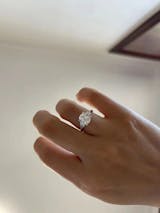THE ART OF DIAMOND CUTTING: FROM ROUGH TO RADIANC
Share

Diamonds have mesmerized humanity for centuries, not just for their rarity or symbolism, but for their unparalleled brilliance. Yet, few people realize that a diamond’s true magic isn’t just in its formation—whether deep within the Earth or grown in a lab—but in the meticulous craftsmanship that transforms a rough stone into a glittering gem. Let’s dive into the fascinating world of diamond cutting, debunk myths, and explore why even lab-grown diamonds owe their sparkle to human ingenuity.
Beyond Hardness: The Human Touch Behind Every Diamond
Both natural and lab-grown diamonds are carbon crystals, identical in chemical composition and physical properties. The key difference lies in their origin: one takes billions of years under extreme geological pressure, while the other is cultivated in weeks using advanced technology. But regardless of their birth story, all diamonds start as rough, unremarkable stones. Their journey to brilliance depends on the same ancient yet evolving art: diamond cutting.
A fundamental question emerges: Given that diamonds rank as the hardest known natural material, by what means can they be cut? The solution combines materials science with centuries of craftsmanship.

The Diamond Cutting Process: From Rough to Radiant
Step 1: Planning—Where Art Meets Algorithms
Cutting a diamond isn’t a task for the impulsive. It begins with high-tech 3D scanning to map the rough stone’s inclusions, cracks, and color zones. Modern software calculates the optimal shape to maximize carat retention, clarity, and brilliance. A poorly planned cut could shatter the stone or waste its potential. For lab-grown diamonds, which often have more predictable structures, this step is slightly easier—but no less critical.
Step 2: Cleaving or Sawing—The First Bold Move
Historically, diamond cutters relied on “cleaving,” striking the stone along its natural grain with a diamond-tipped blade. Today, lasers or diamond-coated saws are often used for precision. Lasers can split a diamond in seconds, minimizing human error. This step creates a “preform,” a rough outline of the final shape.
Step 3: Bruting—Shaping the Sparkle
The diamond's iconic shape emerges during bruting. While traditional methods used two diamonds rotating against each other, modern techniques typically employ a motorized diamond-coated wheel to grind the girdle. Lab-grown diamonds undergo identical processing, matching natural diamonds' hardness.
Step 4: Faceting—The Dance of Light
This is the heart of diamond cutting. Using a rotating wheel coated in diamond dust, artisans hand-cut each facet (the flat, polished surfaces). A classic round brilliant diamond has 58 facets, each angled to reflect light optimally. While machines assist, human judgment is irreplaceable. A fraction of a millimeter in error can dull the diamond’s fire.
Step 5: Polishing—The Final Touch
Facets are polished to remove scratches and ensure mirror-like surfaces. Under microscopes, cutters inspect every angle, adjusting symmetry and proportions. Advanced tools like proportion scanners then grade the cut’s quality, determining its rank (e.g., Excellent, Very Good).

Why Cutting Matters: More Than Just Sparkle
A diamond’s value isn’t just about size or clarity—it’s about craftsmanship. A poorly cut diamond, even with perfect color and clarity, will look lifeless. Conversely, a masterful cut can make a modest stone dazzle. This is why up to 50% of a diamond’s price lies in its cut quality.
For lab-grown diamonds, cutting carries unique stakes. While their rough forms are often more uniform, the pressure to compete with natural diamonds demands perfection. A single misstep in cutting can turn a 2turn a laboratory-grown diamond worth $2,000 into one worth only $500, which is quite disappointing.
Myth-Busting: Human vs. Machine
The original text claims, “Technology does the rough work; humans handle the rest.” This is mostly true—but with nuance. Lasers and scanners have revolutionized planning and splitting, but no machine can replicate a seasoned cutter’s intuition. For example, adjusting facet angles to hide an inclusion requires artistic flair. Similarly, while software predicts light performance, only human eyes can judge a diamond’s “soul.“
Lab-Grown Diamonds: A Cut Above?
Lab-grown diamonds face a perception battle—are they “cheap imitations”? The truth is, their cutting process is equally rigorous. In fact, because their rough forms lack the irregularities of mined diamonds, cutters can often achieve higher precision.
However, risks remain. Lab-grown diamond rough is cheaper to produce, but cutting costs are identical to natural stones. A rushed job to save money can undermine their market appeal. As the industry grows, expertise in cutting synthetics will define brands.

Conclusion: The Unsung Heroes of the Diamond World
Next time you admire a diamond’s sparkle, remember: its beauty was carved by human hands. Whether natural or lab-grown, a diamond is a testament to geology and human artistry. As technology evolves, cutting will remain a blend of math and magic—where algorithms meet the artisan’s touch.
So, are lab-grown diamonds “just as good” as natural ones? In terms of cutting and brilliance—absolutely. But their real value lies in democratizing luxury, proving that whether forged by Earth or science, a diamond’s true worth is unlocked by the craftsmen who shape it.
As the industry says: “God makes the diamonds, but humans make them shine.” And in that alchemy of carbon and craftsmanship, there’s a sparkle no machine can replicate.



